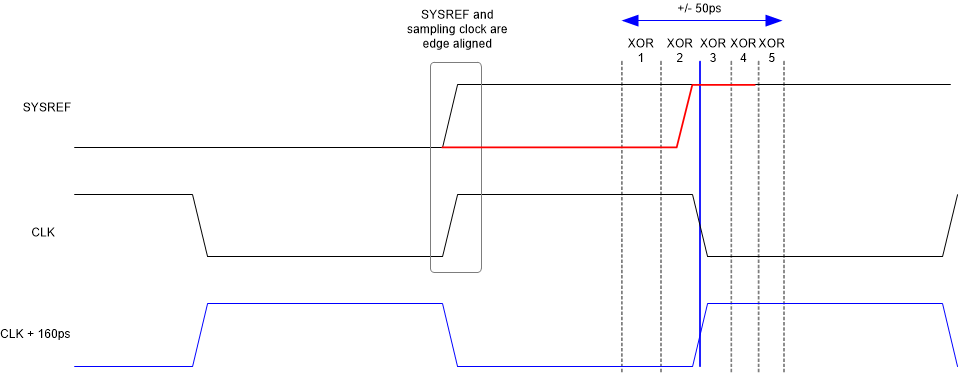SBAS988 November 2023 ADC34RF55
PRODUCTION DATA
- 1
- 1 Features
- 2 Applications
- 3 Description
- 4 Pin Configuration and Functions
-
5 Specifications
- 5.1 Absolute Maximum Ratings
- 5.2 ESD Ratings
- 5.3 Recommended Operating Conditions
- 5.4 Thermal Information
- 5.5 Electrical Characteristics - Power Consumption
- 5.6 Electrical Characteristics - DC Specifications
- 5.7 Electrical Characteristics - AC Specifications (Dither DISABLED)
- 5.8 Electrical Characteristics - AC Specifications (Dither ENABLED)
- 5.9 Timing Requirements
- 5.10 Typical Characteristics
-
6 Detailed Description
- 6.1 Overview
- 6.2 Functional Block Diagram
- 6.3
Feature Description
- 6.3.1 Analog Inputs
- 6.3.2 Sampling Clock Input
- 6.3.3 ADC Foreground Calibration
- 6.3.4 SYSREF
- 6.3.5 Decimation Filter
- 6.3.6 JESD204B Interface
- 6.3.7 Test Pattern
- 6.4 Device Functional Modes
- 6.5 Programming
- 6.6 Register Maps
-
7 Application Information Disclaimer
- 7.1 Application Information
- 7.2 Typical Application
- 7.3
Initialization Set Up
- 7.3.1
Initial Device Configuration After Power-Up
- 7.3.1.1 STEP 1: RESET
- 7.3.1.2 STEP 2: Device Configuration
- 7.3.1.3 STEP 3: JESD Interface Configuration (1)
- 7.3.1.4 STEP 4: SYSREF Synchronization
- 7.3.1.5 STEP 5: JESD Interface Configuration (2)
- 7.3.1.6 STEP 6: Analog Trim Settings
- 7.3.1.7 STEP 7: Calibration Configuration
- 7.3.1.8 STEP 8: SYSREF Synchronization
- 7.3.1.9 STEP 9: Run Power up Calibration
- 7.3.1.10 Step 10: JESD Interface Synchronization
- 7.3.1.11 Step 11: NCO Configuration
- 7.3.1
Initial Device Configuration After Power-Up
- 7.4 Power Supply Recommendations
- 7.5 Layout
- 8 Device and Documentation Support
- 9 Revision History
- 10Mechanical, Packaging, and Orderable Information
Package Options
Mechanical Data (Package|Pins)
- RTD|64
Thermal pad, mechanical data (Package|Pins)
- RTD|64
Orderable Information
6.3.4.1 SYSREF Capture Detection
The SYSREF input signal rising edge should be edge aligned with the rising edge of the sampling clock to maximize the setup and hold times. The ADC34RF5x includes an internal SYSREF monitoring circuitry to detect possible metastability resulting in a clock cycle slip and thus misalignment across devices.
The sampling clock gets delayed by approximately 160 ps and then captures the SYSREF signal. The SYSREF monitoring circuitry provides insights into SYSREF/clock misalignment by detecting whether SYSREF is leading the clock by up to 50 ps or lagging by up to 48 ps. This circuitry will detect and raise one of the SYSREF XOR flags corresponding to the matching SYSREF window below:
- Window XOR1: SYSREF leading sample clock by 25 to 50 ps
- Window XOR2: SYSREF leading sample clock by up to 25 ps
- Window XOR3: SYSREF lagging sample clock by up to 16 ps
- Window XOR4: SYSREF lagging sample clock by 16 to 32 ps
- Window XOR5: SYSREF lagging sample clock by 32 to 48 ps
The SYSREF monitor registers are not sticky registers. They get updated at every rising edge of SYSREF.
 Figure 6-21 SYSREF Detection Circuitry
Figure 6-21 SYSREF Detection CircuitryThe example in Figure 6-22 shows a misaligned SYSREF signal where the SYSREF signal arrives much later than the sampling clock rising edge. The SYSREF window feature checks if the SYSREF transition is within ±50 ps of the instant when the SYSREF signal gets captured by the sampling clock. In this example, the delayed SYSREF signal transitions between the "B" and "C" reverse which raises the XOR2 flag. The XOR flags is reported in register 0x22F in the digital page. Register 0x22F then reads back 0x8B, as shown in Table 6-14.
 Figure 6-22 Detection of SYSREF Transition
within Capture Window
Figure 6-22 Detection of SYSREF Transition
within Capture Window| ADDR | D7 | D6 | D5 | D4 | D3 | D2 | D1 | D0 |
|---|---|---|---|---|---|---|---|---|
| 0x22F | 1 | SYSREF X5 | SYSREF X4 | SYSREF X3 | SYSREF X2 | SYSREF X1 | SYSREF OR | 1 |
| 1 | 0 | 0 | 0 | 1 | 0 | 1 | 1 |